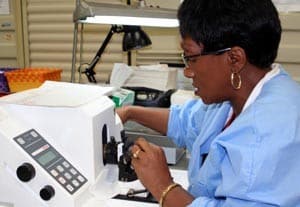Histology Professionals Celebrate Role in Health Care
| March 10, 2010 | “Histo-what?” Histology may not be as familiar to those outside health care as terms like pediatrics or cardiology. Patients are familiar with providing urine or blood samples for analysis by laboratory scientists in UAMS clinics or the UAMS Medical Center, but samples of human tissue are often collected for analysis during surgical procedures. Samples of disease or tumors are taken and prepared by histotechnologists for study that can guide diagnosis and treatment. There are about 20 histotechnologists working in labs at UAMS in both clinical and research areas. Those histology professionals will join colleagues in marking the first National Histotechnology Day on March 10, hoping to raise awareness of their profession as part of the modern health care team. “We are proud of the role our work plays in the treatment and understanding of many disease processes for the physicians and most importantly the patient,” said Pamela Marcum, a histotechnologist and UAMS anatomic pathology manager. “Our profession tends to fly under the radar since a lot of the work is done in a lab away from the patient, but we don’t look at a glass slide with tissue on it without thinking of the patient it came from and the results we need to produce.” Carolyn Black, a UAMS histotechnologist with three decades in the profession, said she was first drawn to the work because of a fascination with every step of the process. This includes using tools that slice the sample into razor thin sections then using liquids that stain the sample to bring more contrast between the different cells and celluar structures when viewed under a microscope. “I think one of my favorite things is to see the end result of a beautifully cut and well-stained slide, which gives us the ability to better analyze the section and help the patient,” Black said. Black noted that she’s seen many changes in the profession during her time, mainly through technology. Computers have allowed more automation of the process, more efficiency and improved tissue analysis techniques. Marcum said there is a national shortage of histology professionals, so job prospects are good in the field. Histotechnologists often work in hospital laboratories, research institutions, industrial laboratories, public health departments or government agencies.
|
